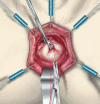Intersphincteric Resection Pushing the Envelope for Sphincter Preservation
- PMID: 29184472
- PMCID: PMC5703671
- DOI: 10.1055/s-0037-1606114
Intersphincteric Resection Pushing the Envelope for Sphincter Preservation
Abstract
During the last 15 years, a significant evolution has emerged in the surgical treatment of rectal cancer and restoration of bowel continuity has been one of the main goals. For many years the treatment of distal rectal cancer would necessarily require an abdominoperineal resection and end colostomy. The surgical procedure of intersphincteric resection has been proposed to offer sphincter preservation in patients with low rectal cancer and has been legitimized if executed according to adequate oncologic criteria. This article will discuss the best indications, technical aspects, functional, and oncological outcomes of intersphicteric resection in the management of rectal cancer.
Keywords: intersphincteric resection; radiochemotherapy; rectal cancer.
Figures









Similar articles
-
Sphincter preservation in low rectal cancer is facilitated by preoperative chemoradiation and intersphincteric dissection.Ann Surg. 2009 Feb;249(2):236-42. doi: 10.1097/SLA.0b013e318195e17c. Ann Surg. 2009. PMID: 19212176
-
Sphincter-sparing resection for rectal cancer.Clin Colon Rectal Surg. 2007 Aug;20(3):203-12. doi: 10.1055/s-2007-984864. Clin Colon Rectal Surg. 2007. PMID: 20011201 Free PMC article.
-
Intersphincteric Resection for Patients With Low-Lying Rectal Cancer: Oncological and Functional Outcomes.Ann Coloproctol. 2018 Aug;34(4):167-174. doi: 10.3393/ac.2018.08.02. Epub 2018 Aug 31. Ann Coloproctol. 2018. PMID: 30208679 Free PMC article.
-
Ultimate Functional Preservation With Intersphincteric Resection for Rectal Cancer.Front Oncol. 2020 Mar 5;10:297. doi: 10.3389/fonc.2020.00297. eCollection 2020. Front Oncol. 2020. PMID: 32195192 Free PMC article. Review.
-
Preservation and restoration of sphincter function in patients with rectal cancer.Can J Gastroenterol. 2000 May;14(5):423-6. doi: 10.1155/2000/215353. Can J Gastroenterol. 2000. PMID: 10851283 Review.
Cited by
-
Rectal cancer lexicon: consensus statement from the society of abdominal radiology rectal & anal cancer disease-focused panel.Abdom Radiol (NY). 2019 Nov;44(11):3508-3517. doi: 10.1007/s00261-019-02170-5. Abdom Radiol (NY). 2019. PMID: 31388697 Free PMC article.
-
Treatment Options for Distal Rectal Cancer in the Era of Organ Preservation.Curr Treat Options Oncol. 2024 Apr;25(4):434-452. doi: 10.1007/s11864-024-01194-4. Epub 2024 Mar 22. Curr Treat Options Oncol. 2024. PMID: 38517596 Free PMC article. Review.
-
Randomized clinical trial of prophylactic transanal irrigation versus supportive therapy to prevent symptoms of low anterior resection syndrome after rectal resection.BJS Open. 2019 Mar 18;3(4):461-465. doi: 10.1002/bjs5.50160. eCollection 2019 Aug. BJS Open. 2019. PMID: 31388638 Free PMC article. Clinical Trial.
-
Comparison of Clinical Efficacy and Safety Between da Vinci Robotic and Laparoscopic Intersphincteric Resection for Low Rectal Cancer: A Meta-Analysis.Front Surg. 2021 Dec 2;8:752009. doi: 10.3389/fsurg.2021.752009. eCollection 2021. Front Surg. 2021. PMID: 34926566 Free PMC article.
-
Functional outcomes of intersphincteric resection in low rectal tumors.Turk J Surg. 2022 Jun 29;38(2):180-186. doi: 10.47717/turkjsurg.2022.5556. eCollection 2022 Jun. Turk J Surg. 2022. PMID: 36483164 Free PMC article.
References
-
- Heald R J, Moran B J, Ryall R D, Sexton R, MacFarlane J K. Rectal cancer: the Basingstoke experience of total mesorectal excision, 1978-1997. Arch Surg. 1998;133(08):894–899. - PubMed
-
- Schiessel R, Karner-Hanusch J, Herbst F, Teleky B, Wunderlich M. Intersphincteric resection for low rectal tumours. Br J Surg. 1994;81(09):1376–1378. - PubMed
-
- Lavery I C, Lopez-Kostner F, Fazio V W, Fernandez-Martin M, Milsom J W, Church J M.Chances of cure are not compromised with sphincter-saving procedures for cancer of the lower third of the rectum Surgery 199712204779–784., discussion 784–785 - PubMed
-
- Rullier E, Zerbib F, Laurent C et al.Intersphincteric resection with excision of internal anal sphincter for conservative treatment of very low rectal cancer. Dis Colon Rectum. 1999;42(09):1168–1175. - PubMed
-
- Gamagami R A, Liagre A, Chiotasso P, Istvan G, Lazorthes F. Coloanal anastomosis for distal third rectal cancer: prospective study of oncologic results. Dis Colon Rectum. 1999;42(10):1272–1275. - PubMed
Publication types
LinkOut - more resources
Full Text Sources
Other Literature Sources
Medical

